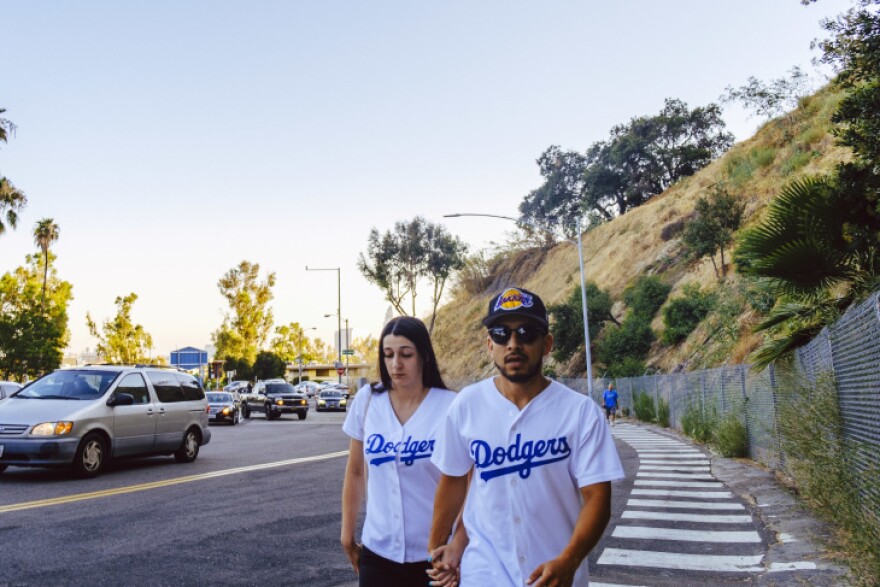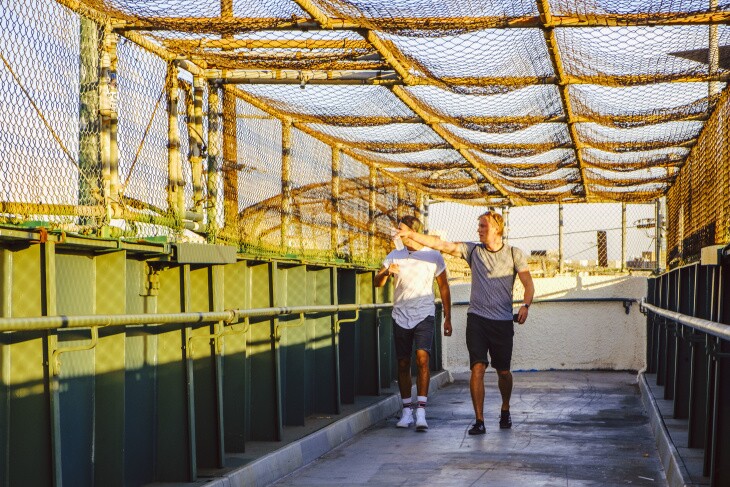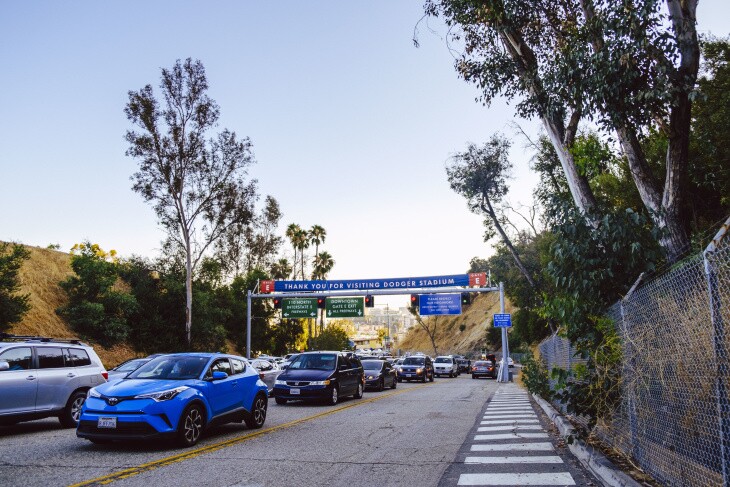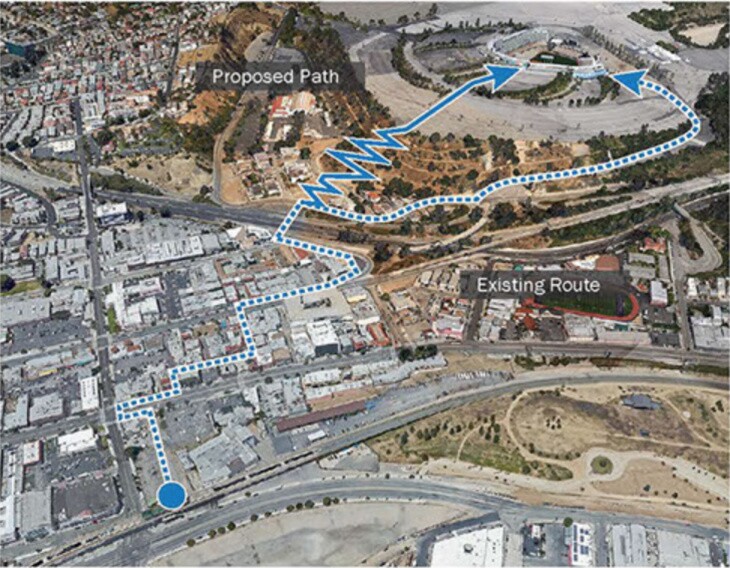Truth matters. Community matters. Your support makes both possible. LAist is one of the few places where news remains independent and free from political and corporate influence. Stand up for truth and for LAist. Make your year-end tax-deductible gift now.
How to intentionally (and safely) walk to Dodger Stadium and save your money for overpriced beer

You're stuck in your car in eight lanes of traffic heading uphill to pay $25 to park at Dodger Stadium. The kids in the back seat chant, "Let's Go Dodgers, Let's Go!"
And you grind your teeth and mutter under your breath, How about let's go faster, Dodgers traffic!
Here's a radical proposal. Why not walk to Dodger Stadium?
The walk up from Broadway in Chinatown takes less than a half-hour, similar for the Sunset Boulevard side of the stadium. I mean, we're a city of people who walk along Venice Beach, and hike Griffith Park and Runyon Canyon. Some 25,000 of us run the L.A. Marathon every year. So you can't say we don't walk in L.A.
You'll spend about the same amount of time stuck in freeway, surface street and entry gate traffic. It's not that much faster to ride the free Metro shuttle bus from Union Station chock-full of fans who've been pre-gaming at local bars (but the shuttle has its own lane, at least).
This calorie-burning, money-saving trudge uphill has been a locals-only thing for years. If you're willing to come out of your vehicular shell, and try a human-powered adventure, here are some things to know about walking to Dodger Stadium.
An update
Note from Sharon McNary:
It’s been a couple of years since I wrote this story about walking or riding a bike to Dodger Stadium.
I walked the route Oct. 11, 2021, and checked with the city and Dodgers and a few walking advocates to see what’s changed.
The walk from the pedestrian bridge from Yale Street over the 110 freeway is as full of cracked sidewalks and untrimmed weeds as it was in 2019, and the walkway on Dodger property up Stadium Way to Gate E is still the same old cracked and bumpy margin of asphalt unprotected from traffic. With general parking costing $30 at the gate, it’s clear that Dodger Stadium is generating enough revenue from parking, you’d think they could spare some cash for better walkways into the park. That said, the crosswalks and pedestrian paths within the stadium are well-marked and carefully overseen by crossing guards.
At Dodger Stadium itself, the new construction of the center field plaza, converting the horseshoe layout of the ticketed area to a complete circle, means there are several new escalators inside the ticketed area. Translation: visitors no longer have to use a specific gate to get to their seats, so they don’t have to make a long walk around the stadium. Just go to the gate that’s nearest your walking route.
There is a geo-fence that bars rideshare electric scooters from accessing Dodger Stadium, fan Todd Munson says. That means scooters will be left at the main gates, and scooter users end up walking up the hills to the entry gates and to the stadium. However, electric powered non-shared bikes and scooters can access the stadium grounds. Todd rides his e-bike.
Pedestrian safety advocate Daveed Kapoor, who lives near the stadium, says the city added a new stop sign at Academy Road and Stadium Way this year. He says it, “may sound minor, but it has made that intersection way safer for drivers, bikers and pedestrians trying to cross the street. Still no sidewalk along the Stadium Way, nor on Academy leading right up to the Academy gate. “
He has also been following the progress of a proposed aerial gondola system to get fans up the hill in seven minutes from Union Station to Dodger Stadium. Under the heading of “connectivity,” the LA Aerial Rapid Transitwebsite says it “will support (a) new proposed pedestrian/bicycle bridge connecting Los Angeles State Historic Park with communities of North Broadway to create access for the local community.
And now back to the original walk and questions I answered:
Is it safe?

This is the big question. Yes, it's fairly safe, but you gotta be heads-up about your personal safety. I've never been threatened by people or cars on the walk, but that doesn't mean it couldn't happen.
The actual walk can be a bit rough. There are sidewalks and signals on most of the big peripheral streets. But not on BOTH sides of ALL streets. On some routes, it's sidewalk on one side, dirt and weeds on the other. If you stick to the route laid out in municipal concrete, you should be fine.
Most of the newer sidewalks are in good condition, however some places have the typical cracks and heaved-up places that make Angeleno walkers feel at home. So, heads up.
Once you're onto Dodger property, you transition from city-maintained sidewalks to the zebra-stripe painted asphalt paths that pass for walkways. For the most part, these walkways are monitored by crossing guards during the most crowded times, and they tend to make for the most efficient path to the stadium gates.
If you try to make your own way, on other non-marked paths, you risk getting hit by drivers trying to get to their seats with a beer before the first pitch.
What routes are best?
It depends on where you're coming from.
From Chinatown: You can take the Gold Line to the Chinatown station on Broadway and walk up from there.
Head up College, make a right on Yale, then it's up a steep helix ramp to the bridge across the 110 Freeway, aka the Arroyo Seco Parkway.
This bridge is kind of grim, lit only by the traffic headlights below, and it is like walking through a chain-link and barbed wire corridor. The Dodgers' head of development, Janet Marie Smith, told me it's "a sore spot" that she would like to see updated, with the cooperation of the city and Chinatown community leaders.

After crossing the bridge, turn right and head up Stadium Way to the ball park's Downtown Gate. When LAist photographer Chava Sanchez walked the route, a rideshare car veered out of the one downhill lane to cut through the pedestrian path.
Another walking route (rank this one as super locals-only) is from North Broadway via Bishops Road to Stadium Way. It takes you over the 110 Freeway tunnel. There's sidewalk on only one side, and it's pretty torn up, but still walkable to the Downtown Gate.
- From Sunset: Come from Sunset Boulevard up Vin Scully Way. There are sidewalks on both sides and crossing signals all the way in to the stadium.
- From Echo Park: Scott Avenue crosses Stadium Way and continues into the park.
- From Elysian Park (where lots of families have pre-game picnics): Academy Road also has a walkable gate.
My best advice is to scan the area using Google Maps to plot your course and check out the road conditions before you go. You can spot the zebra-stripe paths from above and use the Street View function. And, fair warning, remember that everything will look different on the return route when the sun goes down.
Walking is fine, but I want to ride my bike
Cool. It's a pretty good grind uphill, so hope your bike has a nice climbing gear. Same advice: Check it out online before you go.
Dodger Stadium used to have its bike racks in only one place. These days, the racks are spread around to the different entryways (check out this map), so you can park closer to your seats. And it looks like people are using them.
You'll want good front and tail lights for the dark ride back down the hill. I'm uncomfortable leaving my bike locked in the open, so it would be great if the Dodgers could someday add bike valet or lockers to keep my bike safer and its goodies (lights, bell, seat) from being stripped off.
Another alternative are the Metro bikes and the new e-bikeshare bicycles to give you a boost on your ride uphill. There are also a lot of rideshare scooters placed at the major corners as well.
What's being done to make the walk better?

Not much, apparently. A lot of ideas get floated, but for now, none seems to have the heft of the Dodgers or City Hall behind them to make them happen.
The Los Angeles Department of Transportation, likewise, replied to my questions in very general terms about upgrades to sidewalks and signals. But nothing special beyond that seems to be in the works.
Part of the reason is the difficulty of dealing with the fragmented ownership and oversight of all the property involved, said LADOT spokeswoman Nora Frost.
You've got the stadium plunked in the city's Elysian Park, which is overseen by the Recreation and Parks Department. Then there are city-maintained streets and a bridge that crosses a freeway. So lots of stakeholders and decision makers would all need to come together.
Frost said to check with the councilmember's office, so I called the office of Councilman Gil Cedillo, whose district includes the stadium and a few of the gates.
No projects to upgrade the walk through Chinatown and up to the stadium are in the works now, aside from some lighting and sidewalk repairs, according to Conrado Terrazas, a spokesman for the councilman. They would like to see the lighting improved for the bridge over the 110, but that's slow going due to the need to coordinate with Caltrans, which owns the freeway.
Walking advocates have been challenging the city and Dodgers for years to make the stadium easier and safer to get to.
"There's a perception, real or not, that the walk to Dodger Stadium is terrible and it's not safe, [like] there's no sidewalks," said Damien Newton, who edits Streetsblog L.A., a news site covering local mobility and transportation. "That's what we hear all the time."
What kind of changes could be made?
Some of the more interesting ideas come from architect Daveed Kapoor. He put together an extensive rundown of ways to better link Elysian Park and the stadium property to nearby homes and communities. One suggestion: building covered parking structures that could recreate the terrain of Chavez Ravine before it was graded to contain the stadium and its vast parking lots.
He also calls for a new walking bridge to span the 110 Freeway at Radio Hill, and a switchback path from Stadium Way and Lookout Drive up to a pedestrian-only gate to Dodger Stadium.

The photo illustration below is what he wants installed to better mark walking and cycling lanes on routes to Dodger Stadium. To be explicit: THIS IS A FANTASY, IT DOES NOT EXIST IN REAL LIFE.

So what is planned to ease traffic into Dodger Stadium?
The Dodgers are investors in a joint venture to install an aerial gondola line from Union Station on the Chinatown side of the stadium up to the parking lot. That plan is working its way through Metro and an environmental impact report is being prepared.
Another plan is for The Boring Company — owned by Elon Musk — to tunnel from the Vermont light rail station to Dodger Stadium and transport people in small subway cars. The Dodgers organization is not part of that proposal but say it's supportive of the efforts.
Critics of both plans question how much vehicular traffic those systems could cut. Also, sky buckets and underground shuttles that take people only to and from Dodger Stadium would have fairly limited use — on game days or events such as the L.A. Marathon. Extending such systems to connect Dodger Stadium on two sides could make them part of the city's greater transportation network.
At any rate, they would seem to be years off, but you can walk tomorrow.








